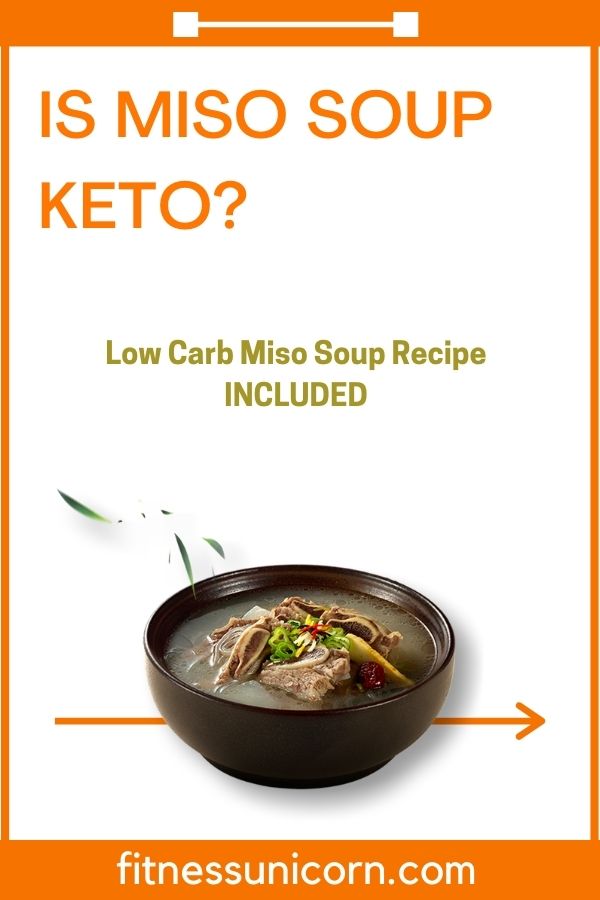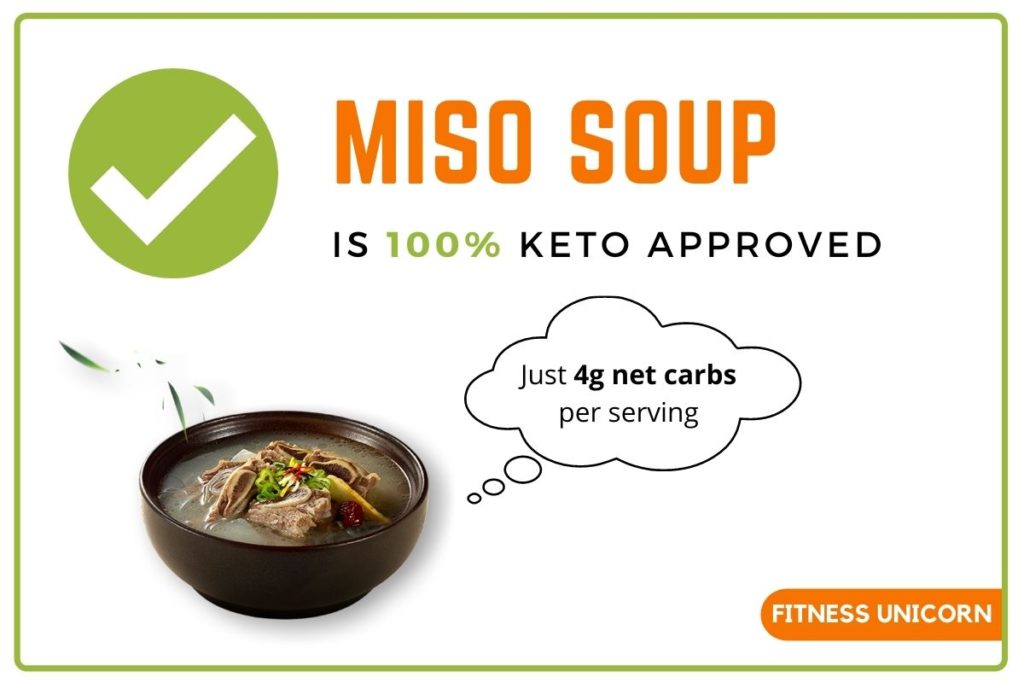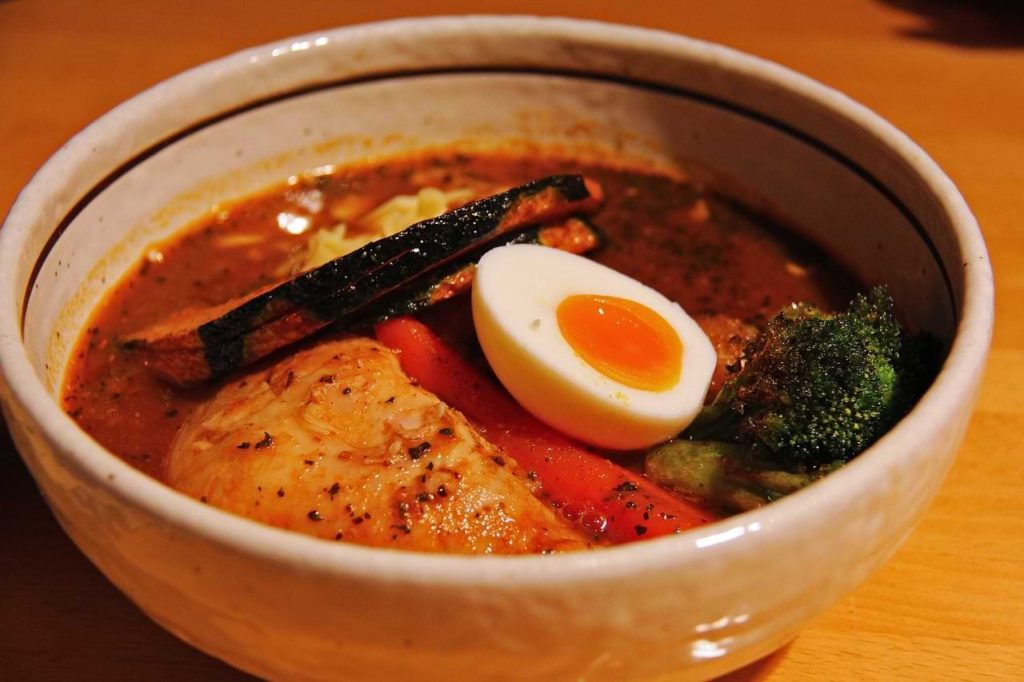Miso soup is a very common delicacy in Japanese cuisine, which is often served with sushi and rice dishes. But if you are on the low carb diet, you may be wondering – Is Miso soup keto?
Miso means “fermented soybean” in Japanese and it has come a long way from Asia. Due to its immense health benefits, Miso is now a very popular ingredient in many Western countries like the U.S.

In this article, you’ll find out how Miso fits in the keto diet, what are the various health benefits. I’ve also shared my favorite beginner-friendly recipe for low carb Miso soup.
Is Miso Soup Keto Approved?
Miso soup is keto friendly as it contains 4g of net carbs per serving.
All of the carbs in Miso soup come from miso paste, which is made by fermenting soybean. You’ll also find other ingredients like salt, green onions, seaweed, or tofu in a miso soup which are also very low in carbs.
Miso Soup is keto only when you have it without the noodles, as they are highly rich in carbs. If you’re really craving the taste, you may try zoodles (zucchini noodles) instead of the real noodles to keep it low carb.
This is one dish that I usually have when feeling sick or generally unwell. Have you heard people saying “Chicken soup fixes everything.” That’s what miso soup does for me.

You can even boost the protein content and vitamins of your Keto Miso soup by adding tofu and mushrooms. They have negligible carbs which makes them the perfect additions to this dish.
Miso is available in all Asian grocery stores and you may also find it in local grocery stores if you are in Europe or North America.
It is such a flexible food item that you could easily grind it with peanut butter to make a keto dip, or combine it with oil and vinegar to make a great salad dressing.
What is Miso?
Miso is a thick paste made by fermenting soybeans with salt and a koji (mold). Japan’s culture has been using it since the eighth century!
Most miso is commonly salty umami in flavor while some of them are also a bit on the sweeter side.
Miso is quite comparable to nut butter in texture and it is basically a cultured mixture of soybeans, a grain like rice, and koji. You may find varying textures from brand to brand and they also have different fermentation durations.
Miso is not a very consistent product and highly varies in terms of color and flavor. It could be slightly tanned, reddish, or even sometimes solid brown as well.
You can readily consume the store-bought miso and it doesn’t require any further preparations. Use it to enhance the flavor of your dishes and add a funky salty flavor to any of your keto dishes, or even desserts!
Since miso contains “good” bacteria, you should always put it at the end of your recipes as the bacteria may die in high temperatures.
You can also make Miso paste at home with this simple recipe:
Is Miso Paste Keto Approved?
1 tablespoon of miso paste contains only 4g of net carbs and hence it is very keto friendly.
You can add it to most Asian dishes to enhance their flavor and also get various vitamins and folic acid in your diet.
I’ve also noticed that the intensity of flavor varies with different brands. If you could get your hands on a strongly flavored Miso paste, you’ll be able to enjoy the same taste with even fewer carbs!
How to Store Miso at Home
Miso has a great shelf life, thanks to the salt added during preparation. It prevents the growth of bacteria that may deteriorate it.
Fermented products generally have a good shelf life. I highly recommend that you store your keto miso paste in a tightly sealed jar in the fridge. Refrigerated miso can usually last for a whole year.
Miso also varies in shelf-life based on its color. The lighter shades of miso have been fermented for a shorter period of time than the dark-brown ones, and hence you should consume it within 1 year.
If you are keeping it in an open jar, make sure you place a plastic wrap on top in order to prevent any discoloration or oxidizing!
You can easily store it at room temperature for 3-6 months, without the need for refrigeration.
Type of Miso
There are 4 major types of Miso pastes based on various factors like color, texture, flavor, etc. These differences arise due to their ingredients, fermentation duration, and the conditions under which the miso is kept.
There is no one-size-fits-all approach when it comes to Miso paste on keto and each one has its own customer-base, depending on your uses.
White Sakiyo Miso
White miso is the lightest in color and sweetest in flavor, compared to all other variants. It has a shorter fermentation period and is made with soybeans and rice.
Since it has a very mild taste, it can be used in dips, marinades, or even keto salad dressings.
Aka Red Miso
Red Miso is made by fermenting soybeans, barley, and other grains. It has a very strong flavor and just half a tablespoon is enough to provide you that great umami flavor.
It’s well suited for meats, vegetables, and soups due to its concentrated flavor.
Shinshu Yellow Miso
Shinshu Miso is the one that lies between white and red Miso. This is your number one pick if you don’t want extremely light or extremely pungent flavor!
It has a very moderate taste and aroma and looks yellow in appearance. Yellow miso is usually fermented for over a year and it makes a great addition to any low carb recipe on keto.
Shiro Awase Miso
Awase Miso has a very light brown shade and it has been fermented for a few weeks. It is a mixture of different types of miso that yields a distinct taste in your keto dishes.
This version of miso also makes for a great dairy substitute in keto recipes, especially if you’re on vegan keto.
Miso Soup Health Benefits on Keto
Miso soup offers tremendous health benefits on a keto diet. Since miso is a fermented product, it is a great source of healthy probiotics that aid digestion.
Probiotics are a must-have in any diet and especially on the high-fat diet because we need a good digestive system to process all those fats! Since buttermilk is high in carbs, miso soup could be a great alternative.
Not just probiotics, Miso soup on a keto diet also enriches you with B vitamins, calcium, iron, magnesium, selenium, and phosphorus, along with folic acid.
In fact, miso paste is one of the rare vegan sources of protein that contains all the nine essential amino acids required for humans.
These are some of the promising health benefits you get with miso soup on the keto diet:
Miso Improves Digestion
Our stomach has billions of bacteria and having the right type of bacteria is the key to a healthy functioning of our system.
A good bacteria profile also aids your digestion and reduces constipation and antibiotic-caused diarrhea or bloating.
Miso contains a probiotic called A. oryzae that has been found to reduce symptoms of various digestive problems such as inflammatory bowel disease (IBD).
The fermented miso also works side by side to reduce the levels of antinutrients present in soybeans. They are called antinutrients because they bind with the nutrients in your stomach and cause a hinderance in their proper absorbtion.
Reduces Risk of Cancers
Research has concluded that frequently consuming miso may be able to lower your risk of certain cancers, such as stomach cancer.
All high salt foods have been linked to an increased risk of stomach cancer. But miso in particular is quite safe even after its high salt content!
For instance, one study compared miso to salt-containing foods such as salted fish, processed meats, and pickled foods.
This study analyzed how miso compares to other high-salt foods such as salted fish and other processed meats.
The fish, meat, and pickled foods were linked to an approx 25% higher chance of developing stomach cancer, whereas miso wasn’t linked to any increased risk.
So what does it mean for you? Next time you’re craving something salty on keto, grabbing a bowl of miso soup would be safer than any processed meat, like beef jerky.
The healthy elements found in soybean compensate for the cancer-causing properties of high salt foods. Miso’s antioxidants may also help you prevent cell damage from free radicals in your body, lowering your risk of cancer.
Strengthens Immune System on Keto
The probiotics in Miso paste strengthens your immune system by promoting the growth of healthy bacteria.
Do you know why doctors recommend having yogurt or fermented products when sick? It’s because the good bacteria can aid your recovery from infections such as common cold.
Since miso is keto friendly, you may enjoy a bowl of soup if the weather has been too harsh on you.
Promotes Heart Health
There is a possible chance that consuming Miso soup is goo for your heart health and reduces the risk of heart disease.
A study concluded that higher levels of isoflavones (present in soybean) lowered the risk of strokes and heart attacks in some Japanese women. However, there is no sufficient data yet to back this up boldly.
One thing to remember is that Miso soup may be too high in sodium depending on the quality of miso paste used.
I prefer the homemade miso soup on keto because I can be sure of what’s going into my bowl! Now I’m going to share with you my all-time favorite miso soup recipe for keto.
Miso Soup Low Carb Recipe
Why waste huge money on dining out when you can make the restaurant-style Keto Miso soup at home?
I’m going to share with you two of my favorite Miso soup recipes with a “slight” difference. The difference is miso itself!
Confused? Well, I mean to say that you can make Miso soup on keto without worrying about carbs from rice (used during fermentation).
One of my miso soup recipes uses Tahini and Tamari sauce to save cut down even more carbs for your keto lifestyle!
Low Carb Miso Soup Recipe
Ingredients:
- 25 g Ginger
- 20 g Garlic
- 2 tbsp Sesame Oil
- 60 g Oyster Mushrooms
- 50 g Shallot
- 30 g Spring Onions
- 10 g Chili Paste
- 200 g Chicken Stock
- 2.5 tbsp Miso Paste
- 2 g Nori Seaweed
- 2 tbsp Turmeric powder
- 2 tbsp Black Pepper
- 15 g Soy Sauce
- 50 g Spinach

Recipe:
- Make a smooth paste from ginger and garlic using a food processor (or use a store-bought ginger garlic paste).
- Put a big pan on medium heat and add sesame oil. Now add the garlic paste, mushrooms, scallions, and onions and stir for few minutes.
- Now bring in the chili paste and the broth, while still stirring.
- Mix in all the other ingredients.
- Finally, add the spinach and let the soup simmer for next 25 minutes (covered).
This keto miso soup recipe yields 8 equal portions.
Nutrition per serving: 70 calories, 4g fat, 2g protein & 6g of net carbs
Keto Miso Soup Using Tahini
This recipe tastes similar to the original miso soup, but with much fewer carbs (just 3 grams!). It also includes low carb noodles (shirataki) that makes it quite a filling meal!
Tahini sauce and tamari sauce will be our substitutes for the miso paste that will lower the carb amount.
Here are the ingredients:
- 2 (3 oz or 85 g) packs of shirataki noodles,
- 2.5 cups of chicken broth
- 1 tbsp of tahini sauce
- 1 tbsp of gluten-free tamari sauce
- 220g of peeled shrimp
- 1 tsp of sesame oil
- 2 tbsp of lemon juice
- 2 green onions thinly chopped
- 30g of spinach sliced

Recipe:
- Rinse and drain the shirataki noodles and keep them aside.
- Put a pan on medium heat and add the broth, tahini sauce, and tamari sauce. Once the vessel becomes steaming hot, add in the shrimp, sesame oil, and lemon juice and cook for a few minutes.
- Now add the drained noodles along with other vegetables.
- Your asian keto miso soup is ready to be served!
This recipe yields 2 servings.
Nutrition per serving: 221 calories, 10 g fat, 7 g protein & 4 g of net carbs
Keto Friendly Toppings for Miso Soup
There are plenty of keto-friendly additions to your miso soup that can enhance the taste and nutrients:
- Chicken
- Salmon
- Turkey
- Beef
- Shrimp
- Mushrooms
- Tofu
A dash of hot sauce gives a nice touch up to this ancient Japanese delicacy!
Conclusion
Is Miso Soup Keto friendly?
Miso soup is keto-friendly as it contains 4-6 grams of carbs depending on the type of miso paste used.
Soups made with darker Miso paste require less quantity of the paste and hence they have fewer carbs. Consuming miso has various health benefits like improved digestion, better immune system, improved heart health, etc.
Adding low carb items like mushroom, tofu, beef, chicken can enhance the health benefits and make your soup tastier!
Miso soup in restaurants can be quite high in sodium and hence I’ve shared these two beginner-friendly and delicious low carb recipes.
